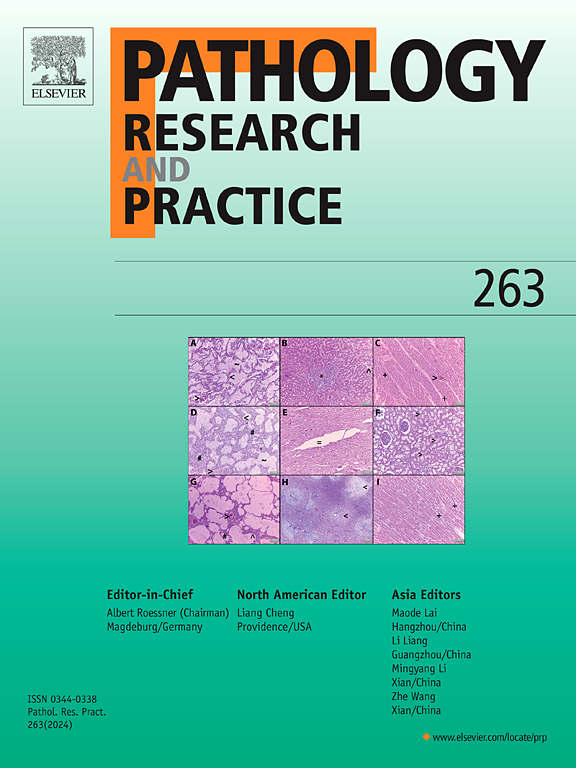EZH2 regulatory roles in cancer immunity and immunotherapy
IF 2.9
4区 医学
Q2 PATHOLOGY
引用次数: 0
Abstract
Enhancer of zeste homolog 2 (EZH2) is a polycomb repressor complex 2 (PRC2) subunit that is responsible for silencing expression of target genes through generation of lysine 27 trimethylation on histone H3 (H3K27Me3). EZH2 is an oncogene aberrantly expressed in human cancers, and its overexpression favors immune escape and metastasis. Immune escape occurs via the impact of EZH2 on hampering antigen expression machinery, stabilizing FOXP3 in regulatory T cells (Tregs), inhibiting recruitment and activity of natural killer (NK) and CD8+ T cells, and inducing recruitment and activity of myeloid-derived suppressor cells (MDSCs). Besides, EZH2 also promotes intra-tumoral recruitment of tumor-associated macrophages (TAMs). A point is that pharmacologic EZH2 inhibition (not knockdown) seemingly promotes polarization of macrophages toward pro-tumor M2 phenotype, which defines resistance mechanism. Besides, increased EZH2 expression after anti-cytotoxic T lymphocyte associated antigen-4 (CTLA-4) and a rise in the tumoral expression of programmed death-ligand 1 (PD-L1) after EZH2 inhibition account for secondary immunosuppression in tumor ecosystem after immunotherapy, indicating the applicability of using EZH2 targeted therapies as a combinatory approach with anti-programmed death-1 (PD-1) or anti-CTLA-4 therapy. Such combination reinvigorates anti-tumor immunity and presumably hampers T cell exhaustion and acting as a promising regimen for retarding cancer growth.
EZH2在肿瘤免疫和免疫治疗中的调节作用
zeste homolog 2增强子(Enhancer of zeste homolog 2, EZH2)是一种多梳抑制复合物2 (PRC2)亚基,通过在组蛋白H3 (H3K27Me3)上产生赖氨酸27三甲基化,负责沉默靶基因的表达。EZH2是一种在人类肿瘤中异常表达的癌基因,其过表达有利于免疫逃逸和转移。免疫逃逸是通过EZH2影响抗原表达机制,稳定调节性T细胞(Tregs)中的FOXP3,抑制自然杀伤细胞(NK)和CD8+ T细胞的募集和活性,以及诱导骨髓源性抑制细胞(MDSCs)的募集和活性发生的。此外,EZH2还促进肿瘤相关巨噬细胞(tumor associated macrophages, tam)在肿瘤内的募集。有一点是,药理学上EZH2抑制(而非敲低)似乎促进了巨噬细胞向促肿瘤M2表型的极化,这定义了耐药机制。此外,抗细胞毒性T淋巴细胞相关抗原-4 (CTLA-4)后EZH2表达升高,EZH2抑制后程序性死亡配体1 (PD-L1)的肿瘤表达升高是免疫治疗后肿瘤生态系统继发性免疫抑制的原因,这表明EZH2靶向治疗可与抗程序性死亡-1 (PD-1)或抗CTLA-4治疗联合使用。这种组合重新激活了抗肿瘤免疫,可能阻碍了T细胞的衰竭,并作为一种有希望的延缓癌症生长的方案。
本文章由计算机程序翻译,如有差异,请以英文原文为准。
求助全文
约1分钟内获得全文
求助全文
来源期刊
CiteScore
5.00
自引率
3.60%
发文量
405
审稿时长
24 days
期刊介绍:
Pathology, Research and Practice provides accessible coverage of the most recent developments across the entire field of pathology: Reviews focus on recent progress in pathology, while Comments look at interesting current problems and at hypotheses for future developments in pathology. Original Papers present novel findings on all aspects of general, anatomic and molecular pathology. Rapid Communications inform readers on preliminary findings that may be relevant for further studies and need to be communicated quickly. Teaching Cases look at new aspects or special diagnostic problems of diseases and at case reports relevant for the pathologist''s practice.

 求助内容:
求助内容: 应助结果提醒方式:
应助结果提醒方式:


